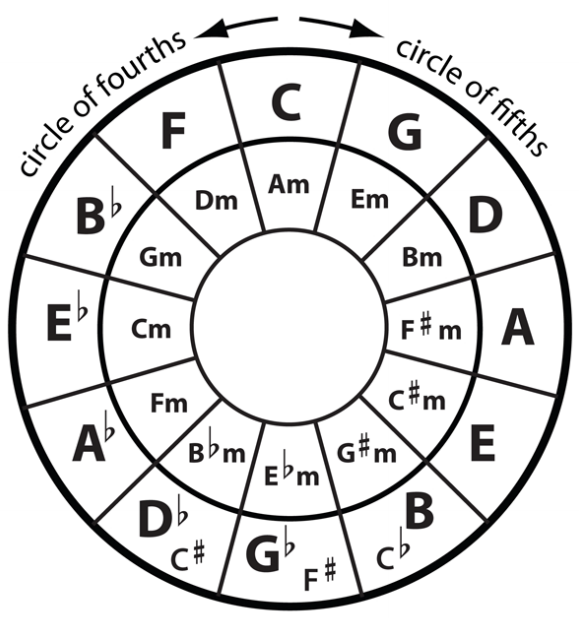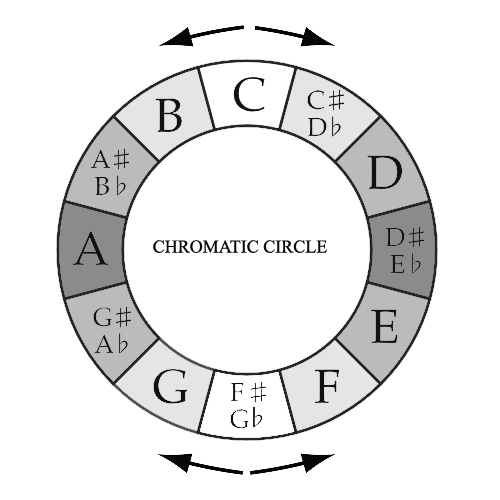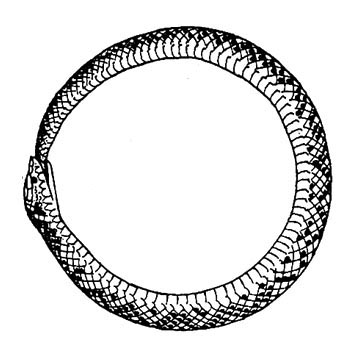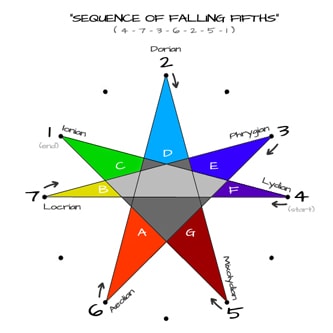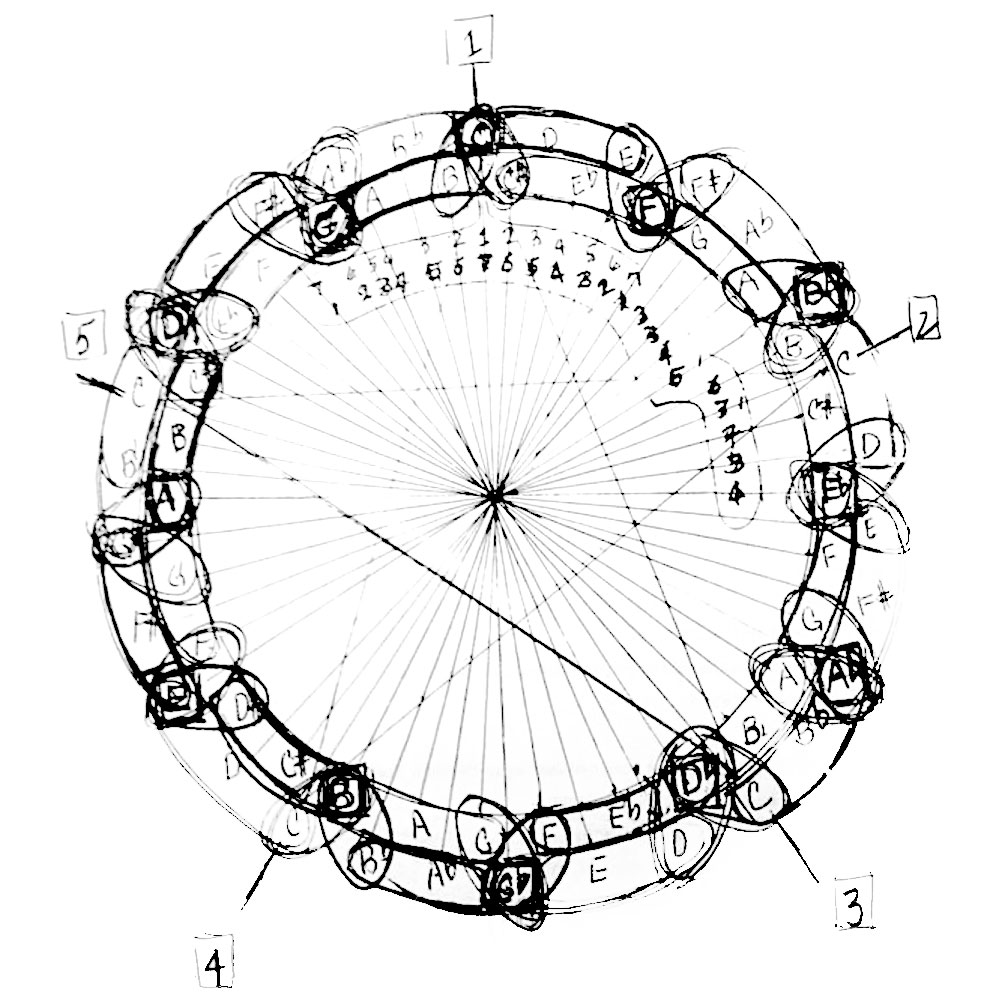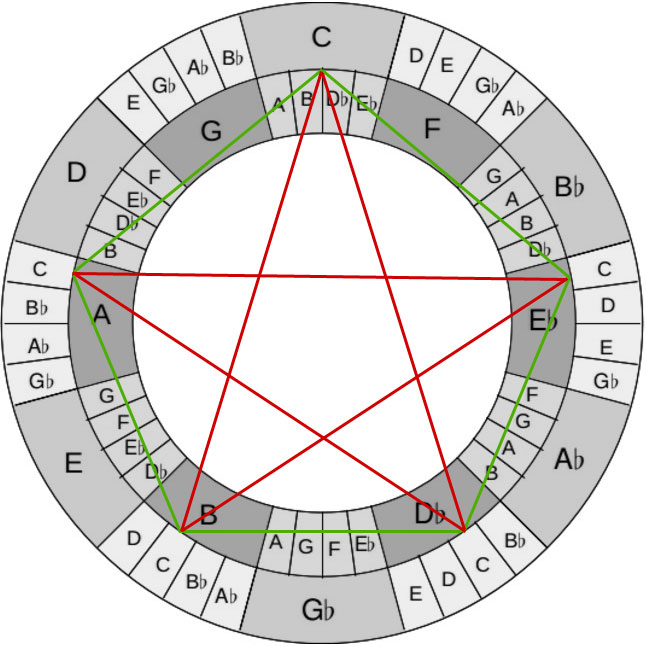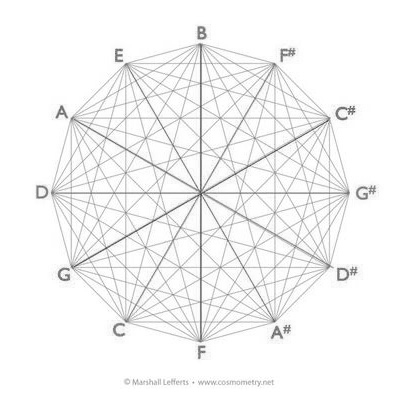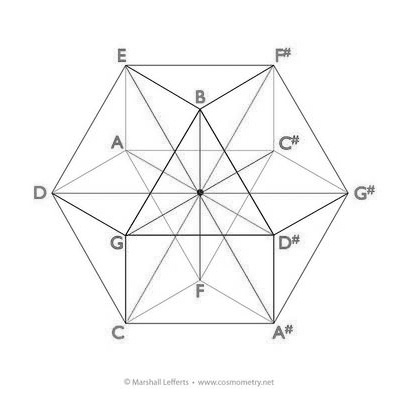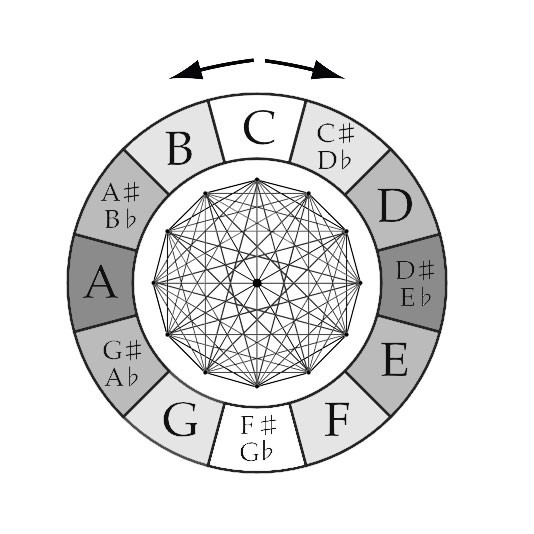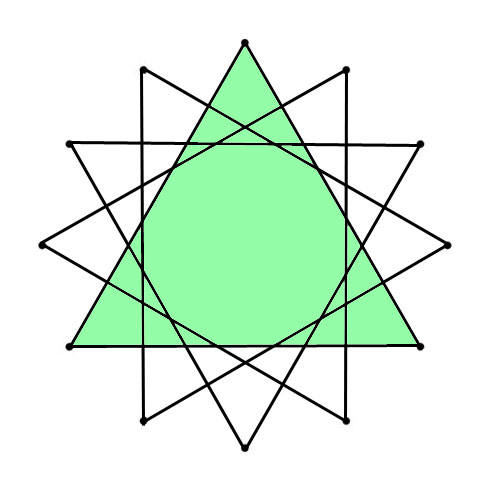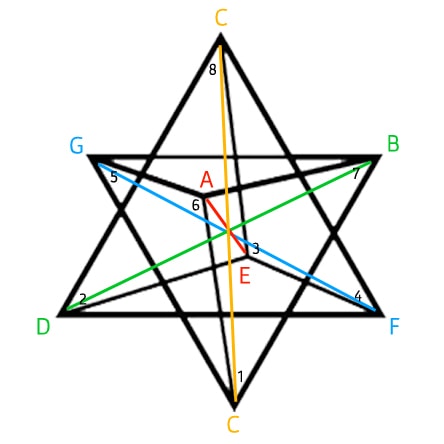MUSIC & GEOMETRY – PART 2 – HARMONY
Before we continue exploring geometric shapes of harmony first some additional information about tone circles and harmony … Tone Circles are a very important tool when it comes to harmonic progression (or chord progression) in music.
RELATIVE MAJOR / MINOR TONALITIES
You see here the Circle of ascending Fifths/Fourths with both Major and minor tonalities. The relationship between the Major and minor tonalities is of course the same in the Chromatic Circle.
Even though the relative Major and minor are on the same side of the circle they do not automatically “replace” each other musically.
For example: the geometric relationship C Major and G♭ Major is the same as the geometric relationship between A minor and E♭ minor. The relationship between C Major and E♭ minor might look the same geometrically within the circle but is a different one! The tonic of C Major is a Tritone apart from G♭ Major, but only a minor 3rd apart from E♭ minor.
In these articles about music and geometry I have chosen to only us the circles with Major tonalities to have more space for drawing lines between the tones of the circle that form the geometric shapes (polygons and polygrams).
DIFFERENCES BETWEEN THE CHROMATIC CIRCLE AND THE CIRCLE OF FIFTHS:
You might have noticed that the tone circles above have different “shades of grey” for their tones. This is done for a reason. From a “philosophical” point of view you could say that – when you look at the “movement” around the circles – the Chromatic Circle represents ‘Polarity‘ and/or ‘Dualism‘ and the Circle of Fifths represents ‘Unity‘ and/or ‘Nondualism‘.
Of course the Circle of Fifths can be read counterclockwise as well, but than it would not longer be the Circle of Fifths but the Circle of Fourths instead. In other words, the Chromatic Circle is bidirectional (same interval size in both directions) and the Circle of Fifths (clockwise) unidirectional, as is the Circle of Fourths (counterclockwise).
CHROMATIC CIRCLE
When we look at the Chromatic Circle, then we can see two “poles”, C and F♯/G♭. From these “poles” we move around the circle in both directions. Now, imagine placing a “mirror” from C to F♯/G♭, then:
B is “mirrored” by C♯ | D♭ → (5♯/7♭ | 7♯\5♭),
A♯ | B♭ is “mirrored” by D → (10♯/2♭ | 2♯\10♭),
A is “mirrored” by D♯ | E♭ → (3♯/9♭ | 9♯\3♭),
G is “mirrored” by F → (1♯/11♭ | 11♯\1♭),
G♯ | E♭ is “mirrored” by E → (8♯/4♭ | 4♯\8♭).
F♯ | G♭ “mirrors” itself within → (6♯ | 6♭),
as does C → (0♯ | 0♭).
The numbers of ‘accidentals’ stays the same but the “polarity” has changed (sharp to flat, positive to negative, “male” to “female”).
The two opposites of Yin and Yang (the image on the right, turned 90 degrees to align with the tone circle) attract and complement each other and, each side has at its core an element of the other (represented by the small dots). Neither pole is superior to the other and, a correct balance between the two poles must be reached in order to achieve harmony.
To me the Yin and Yang symbol (circle) represents Octave (complete scale), the Tritone interval (geometric mean) “splits” the octave in half: black half (Yin), white half (Yang). The dots represent the two most important intervals in music, the white dot = 5th (3:2, arithmetic mean – Yang, the sun) and the black dot = 4rd (4:3, harmonic mean – Yin, the moon). Both “lead” to the opposite half, across the “border” (the Tritone), the white dot to the white half (down, 5th to the Tonic) and the black dot to the black half (up, 4th to the Octave).
CIRCLE OF FIFTHS
When going around the Circle of Fifths the build-up and decrease of the number of sharp and flats is constant. The sharps going up 0-11 while the flats go down simultaneously 11-0. And another pattern to be seen: 0 – 1 – 2 – 3 – 4 – 5 – 6 – 5 – 4 – 3 – 2 – 1 (- 0).
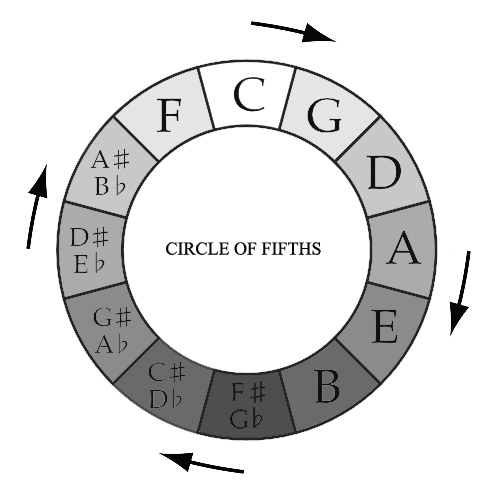
GEOMETRY OF CHORDS
Just like with scales also chords form geometric shapes. For this article I will only share the shapes and Polygons for C Major and C Minor. These shapes are the same though for all 12 tonalities.
TRIGON (triangle)
The clockwise “connected” tones are a Major Third (400 cents) apart from one another: The triad formed by playing all 3 tones of the trigon together is called “Augmented Triad“. C-E-A♭ & A♭-C / G-B-E♭ / D-G♭-B♭ / D♭-F-A.
SQUARE
All 4 tones (C-G♭-E♭-A / D-A♭-F-B / E-B♭-D♭-G ) together forms a “Diminished 7th Chord“, containing two simultaneous played TriTones a Minor Third apart.
Every first image bellow visualizes the Chromatic Circle (CC), every second the Circle of Fifths (CoF).
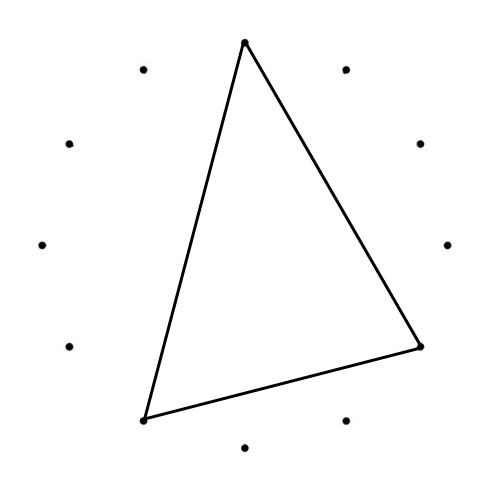
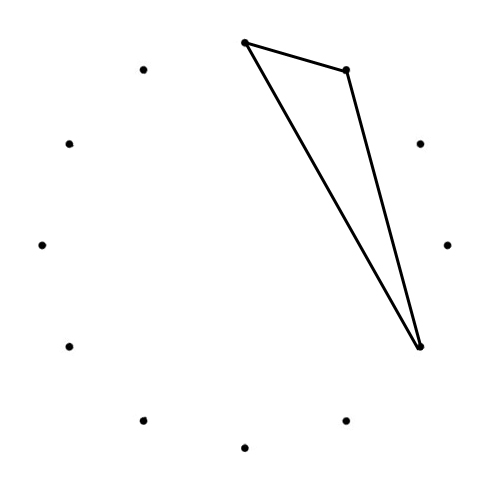
C MAJOR (CM)
.jpg)
.jpg)
C MINOR (Cm)
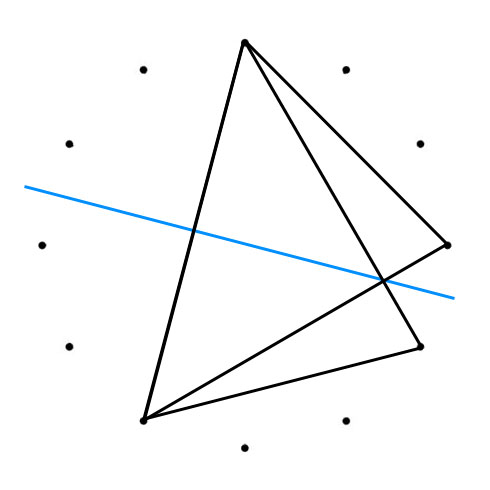
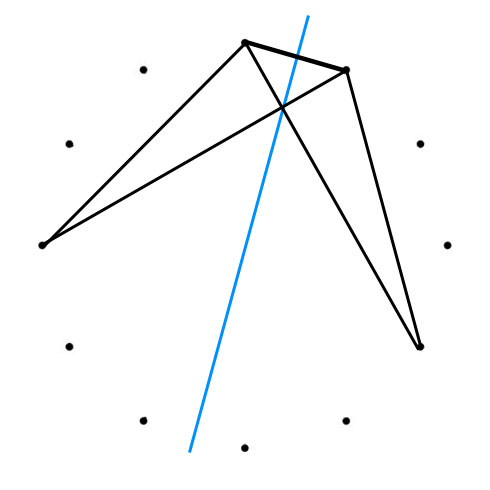
SUPERIMPOSED MIRRORED
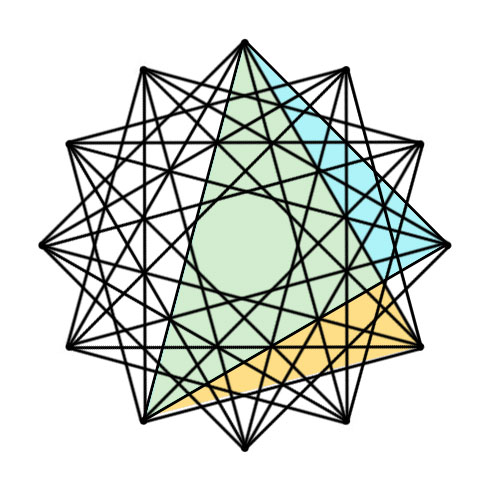
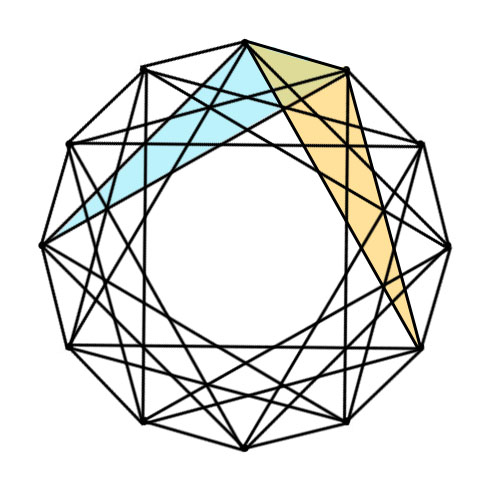
12 TONALITIES
Other common chords in all 12 tonalities superimposed (the colored polygons are C chords). Every first image bellow visualizes the Chromatic Circle (CC), every second the Circle of Fifths (CoF).
C dim
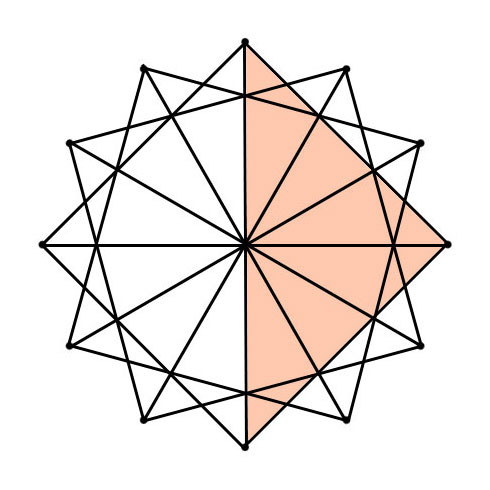
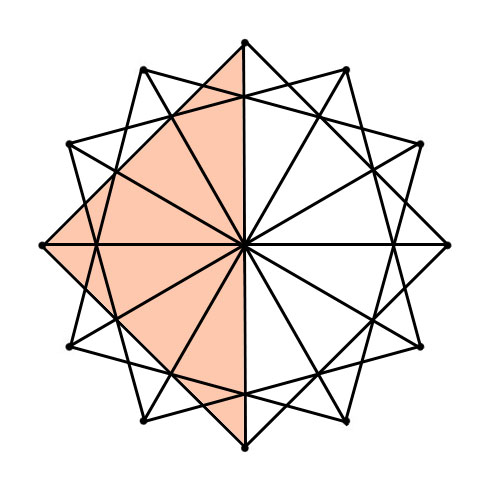
C Aug
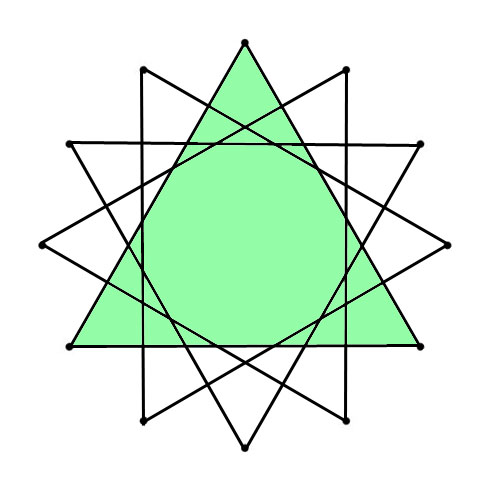

Cm7
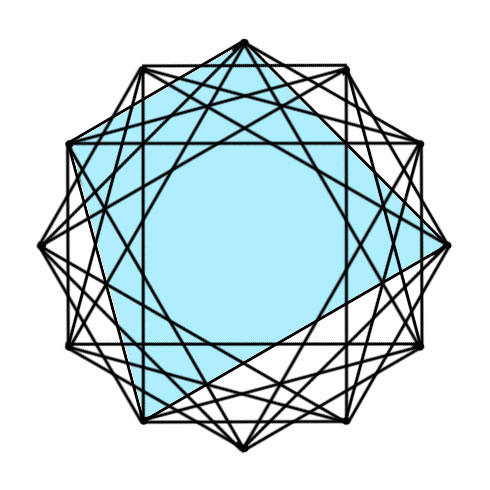
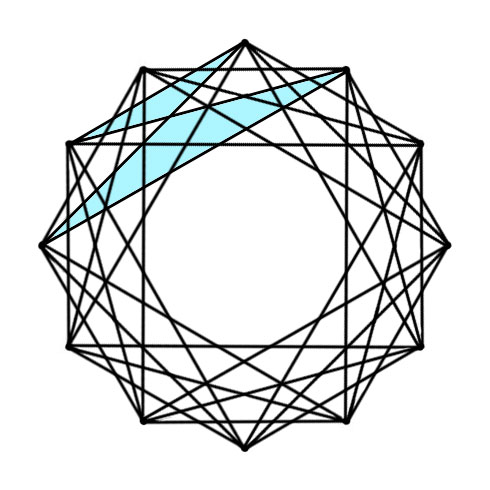
C7
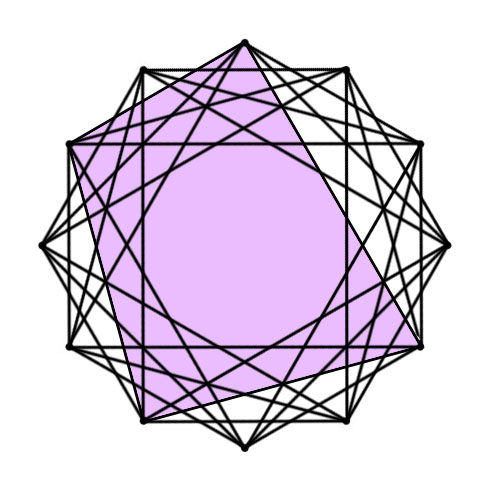
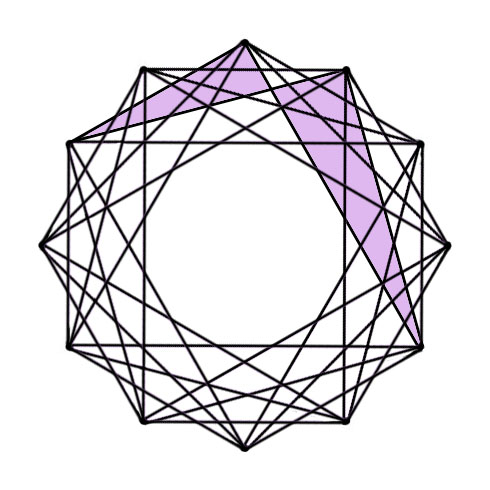
CM7
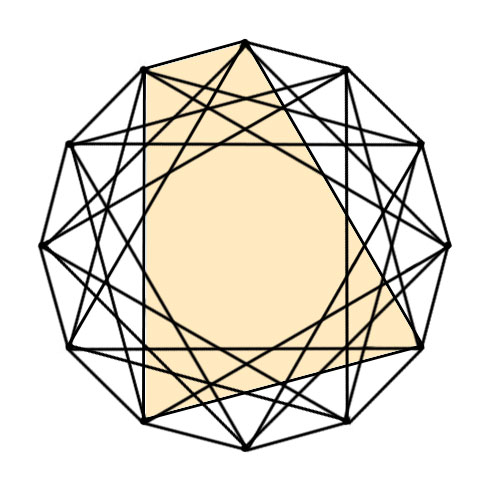
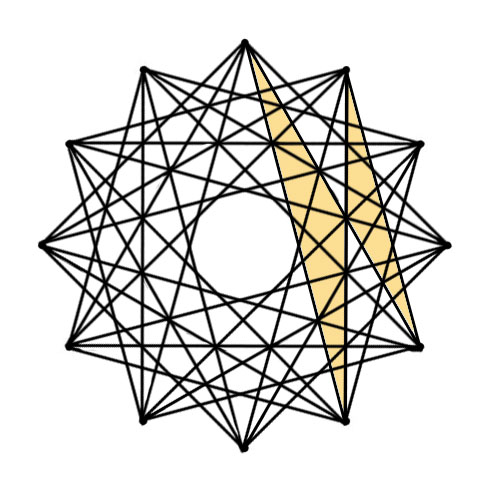
As you might have noticed, there are various chords that “generate” the same image when all 12 tonalities have been superimposed, no matter if you use the polygons of the Circle of Fifths or the Chromatic Circle.
There are of course many more chord variations with additional tones such as a 4, 6, 9, 11 and others.
HARMONIC PROGRESSIONS
When you draw a square around the Circle of Fifths and draw lines between the corners of the square, 4 triangles appear. In each triangle we see the chord progressions that belong to the Major tonality in the center of the outer ring, highlighted by the green triangle. Diminished chords are usually not drawn into the tone circle, but to complete the picture I have added it into a 3rd ring in the center.
This concept only works with the Circle of Fifths. It does not work this way with the Chromatic Circle.
The example below is based on C Major, but you could turn the Circle of Fifths in any direction to see the chord progressions for any other Major tonality.
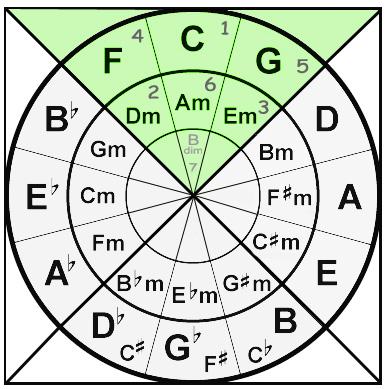
| DEG. | TONE | FUNCTION | CHORD |
| 1 | C | TONIC | C MAJOR |
| 2 | D | SUPERTONIC | D MINOR |
| 3 | E | MEDIANT | E MINOR |
| 4 | F | SUBDOMINANT | F MAJOR |
| 5 | G | DOMINANT | G MAJOR |
| 6 | A | SUBMEDIANT | A MINOR |
| 7 | B | LEADING TONE | B DIMINISHED |
Two examples below of the ‘movement’ created by chord progressions:
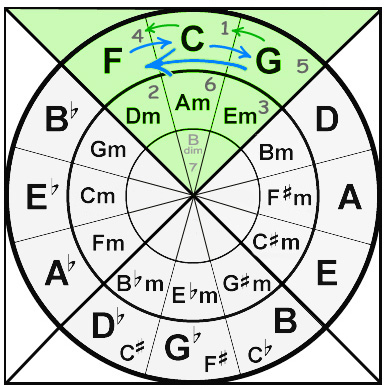
BLUES PROGRESSION
A standard Blues uses the 1st, 4rd and 5th degrees:
I → IV → I → V → (IV) → I
See how the movement between the chords of a standard Blues takes place in the outer ring (chords with a Major 3rds).
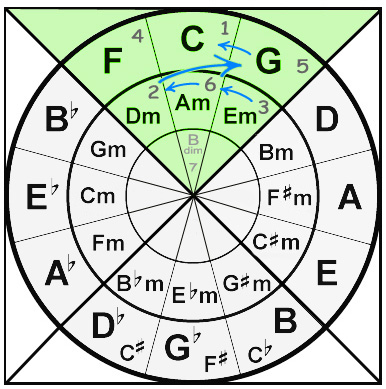
TURNAROUND
Standard turnaround uses the 1st, 2nd, 3rd, 5th and 6th degrees:
III → VI → II → V → I
A turnaround creates a “z-like” patern, from the inner ring (minor 3rds) to the outer ring (Major 3rds).
THE “SEQUENCE OF FALLING FIFTHS”
The purple Septagram displayed earlier also visualizes another aspect in music as well: the “harmonic progression” or “chord progression“, a succession of musical chords. This chord progression is the foundation of harmony in the Western musical tradition.
The numeral sequence of the falling (descending) Fifths goes as follows:
(4 -) 7 – 3 – 6 – 2 – 5 – 1
Musicians and composers generally prefer using the Roman numerals instead though:
(IV -) VII – III – VI – II – V – I
In C Major we get the following chord sequence:
(F Major -) B diminished – E minor – A minor – D minor – G Major – C Major.
All “steps” in the sequence “lead” to the tonic, the root of the tonality a composition is written in. I’ve put the (IV) in the sequence above between brackets, because the interval between F and B is not a Fifth but a Tritone.
“THE SEQUENCE OF FALLING FOURTHS”
If you place the 4 on the other side of the reversed sequence then we get a perfect sequence of descending Fourths”: 4 – 1 – 5 – 2 – 6 – 3 – 7:
F Major – C Major – G Major – D minor – A minor – E minor – B diminished.
This “Sequence of Falling Fourths” actually appears when you use the RADIAN measure of 57.29577951 degrees when going ’round the Circle of Fourths (or Circle of Fifths in clockwise movement), as Zachary G Covell demonstrates (see image on the right).
Zack writes: “After 7 times around the circle all four of the 90 degree lines are filled in. The 11th, 22nd, 33rd, and 44th step in the lines placing each one at a new radian of 57.29577951 degrees becomes the axes of the directions at 90 degrees to one another. Only a musician or someone who knows some music theory will see the 4152637 locations. The 4152637 are Harmonic Progression in Music.“
Going around the Circle in 7 times isn’t a “coincidence” either. When stacking (slightly tempered) Fourths / Fifths you will rise 7 octaves before you come across the “same” tone as you started with (but 7 octaves higher) and “close” the circle. I talk about “tempered” Fourths / Fifths in this case, because if you stack Just (perfect) Fourths / Fifths you would slightly ‘overshoot’ the circle with approx. a quartertone (this difference between 12 stacked Perfect 5ths and 7 stacked Octaves is also called the “Pythagorean comma“) and would thus generate a spiral and not close the circle, as demonstrated by Zach.
The 11th, 22th and 44th are Tritones. The 33rd is not (it’s a “Quartertone“), nor are the 55th, 66th, and 77th. But the 88th is, as is the 176th … This is because there are some “doubling sequences” within the harmonic series as well. The most obvious is that of the 1st harmonic (fundamental): 1-2-4-8-16-32-64-et cetera. But, so does the “Tritone” in the harmonic series: 11-22-44-88-176-352-et cetera. The 33rd harmonic (a “Quartertone”) “doubles” as follows: 33-66-132-et cetera, as does the 55th harmonic: 55-110-220-et cetera … you see the “system of doubles” within the harmonic series, right?
For the “number fetishists” and philosophers among us:
The numerologists among you might have noticed the 11, 22, 33 and 44 series, the so called “Master Numbers” (although not all numerologists use 44).
These numbers are also the first 4 double digit palindromic numbers, numbers that remains the same when its digits are reversed. The Circle of Fifths can be used both ways, the interval stays the same only the direction changes, ascending (clockwise) vs. descending (counterclockwise) 5th.
In the Bible the numbers 11 and 22 symbolize disorder, chaos and judgment. The Tritone is commonly experienced as the most “dissonant” or “tensionful” in the 12-Tone system. 33 represents “God’s Judgement”.
If you count from the 1st line drawn in the circle, the 33rd Harmonic becomes the last “leg” of the cross and the beginning of the last “sequence” (of 4) to close the circle/cycle.
In the Bible a 44 day period began on the day Jesus was crucified and ended with his resurrection. When you look at the circle, the 44th harmonic completes / ends the circle/cycle. It “ends” the “period” between “crucifixion” (33rd Harmonic) and 44th Harmonic.
I know these things don’t have much to do with math or geometry, but are fun nonetheless. *wink*
“AUTUMN LEAVES” PROGRESSION & THE GEOMETRY OF THE AUTUMN EQUINOX
When you “map” the chord progressions of some compositions using the Circle of Fifths, geometric shapes may appear as well. Robert Aguirre discovered a very interesting one, relating the Jazz standard “Autumn Leaves” with the Autumn Equinox:

“Since you went away the days grow long … And soon I’ll hear old winter’s song …“
THE COLTRANE CIRCLE
An interesting variant to the “Circle of Fifths” is the “Coltrane Circle”, created by saxophonist John Coltrane (perhaps based on Nicolas Slominksy’s Thesaurus of scales and musical patterns?) and was used by Yusef Lateef for his work “Repository of Scales and Melodic Patterns“.
Being a saxophonist myself and a fan of Coltrane’s work I had no choice then to write something about this tone circle in this article as well.
Below on the left you see a scanned copy of an original drawing of the “Coltrane Circle”. I have modified an image made Corey Mwamba from his article “Coltrane’s Way Of Seeing” that clarifies the scanned image (right image).
A Pentagram & Pentagon appear when you draw lines between the same tones in the Coltrane Circle” (in this example with the tone C).
In the original drawing Coltrane had “circled”. specific tones. If you connect the circled tones a dodecagram is formed.
NOTE: There is a lot more that can be said about the Coltrane Circle as well as the geometric relationships between chords and chord progressions in some of his music, in particular the album Giant Steps. If you like to know more about this, then read this Roel’s World article: “The Coltrane Tone Circle“.
POLAR HARMONY – CHANGING “POLARITY” (“NEGATIVE HARMONY”)
The following images are based on a concept shared by Ernest Levy (writer of “A Theory of Harmony“) where every chord has a “reflection”, a “polar opposite” chord within that key center, created by rotating every single tone around the axes of that key center. With other words, with this concept you can substitute a chord by changing it’s “polarity”. Some musicians refer to this method as “Negative Harmony”. The mirror “reflection” is representative of the reflective qualities between the harmonic and subharmonic series, (“otonality & utonality“).
In this concept the axes between the tonal center (root) and Fifth (the interval between the second and third harmonics, generally considered as the most important and consonant interval) is used to “mirror” chords and scales.
A simple way to visualize it is to “mirror” the chord in the Tone Circle.
In the first image you see the polygon of G7 and the the tonic of C. In order to create the “mirror” in the Chromatic Circle (1st images) you need to draw a line between the tonics of the G7 and C chords and add perpendicular to this G – C axis the “mirror” (image 2). In image 3 you see the mirrored polygram of G7, that turns out to be a F Minor 6 (as noted in the 4th image). The process is pretty much the same with the Circle of Fifths (2nd images), except that you add the “mirror” directly in between the tonic and fifth of the tone center.
G7
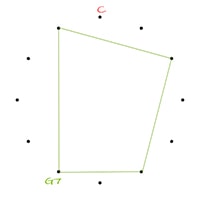
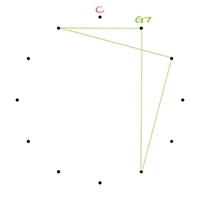
AXIS & MIRROR
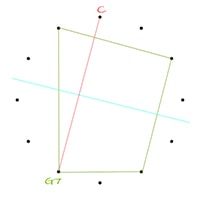
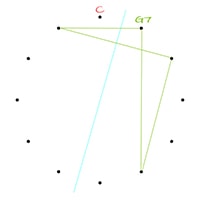
MIRROR G7
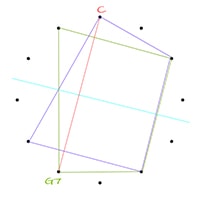
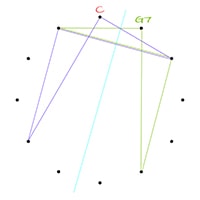
Fm6 (AXIS)
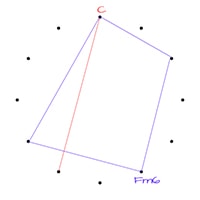
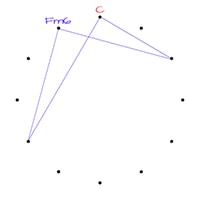
Substituting G7 with Fm6 is changing the direction of approach to resolve at C. G to C is a Descending Fifth, F to C an Ascending Fifth. The F Minor 6 chord could also be seen / notated as a D7b5 chord, but it will not “accentuate” the dominant function as traditionally with G7 or alternatively it’s “reflection” Fm6.
Famous musicians like saxophonist Steve Coleman (interesting read: Symmetrical Movement Concept) and Herbie Hancock have used “Negative Harmony” in their music. This subject gained most “exposure” and “popularity” recently due to Youtube videos by/with Jacob Collier.
TONNETZ GRID
Another way to visualize (and perhaps easier way to “map” the “polar conversion” of) a chord, is by using the Tonnetz Grid. In musical tuning and harmony, the Tonnetz Grid (German for tone-network) is a conceptual latticediagram representing tonal space first described by Leonhard Euler in 1739.
This way of visualizing “negative harmony” can be found in detail at this imgur post. For this Roel’s World article I will only show you the example as described above with G7 and C. I’ll use a Tonnetz Grid image by Jan Ott for it:

As you might have noticed, the in the Tonnetz Grid “connected” tones on the horizontal lines are a 5th apart. The tones connected diagonally from left-top to right-bottom are a Minor 3rd apart, the tones connected diagonally from bottom-left to top-right are a Major 3rd apart.
3 DIMENSIONAL REPRESENTATION
Some authors have taking mapping tone relationships one step further, turning the more “traditional” 2D Polygons into 3D shapes. At the website www.cosmometry.net for example Marshall Lefferts converted the 2D Circle of Fifths into a 3D Vector Equilibrium.
Marshall Lefferts writes: “This illustration shows that the tri-tone intervals are exactly opposite each other in the circle of fifths”. [left]
“In this way we can easily see the six pairs of opposite notes that comprise the basic 12-tone system of music.”
“Extending this into the 3-dimensional space of the vector equilibrium, one of the primary components of cosmometry, we can map these pairs like this (notice that the circle of fifths is maintained in the sequence of notes as they are arrayed visually around the center).” [image right]
“Buckminster Fuller stated that the vector equilibrium is composed of six-pairs of equal and opposite vectors radiating from its center point. The music system aligns with that model conceptually, though of course the frequency differences of the actual tri-tone notes are not equal.”
Instead of blogging more about the 3 dimensional representations of musical harmony and tone-relationships it might be more useful to share some very interesting videos made by others with you:
NEO-RIEMANNIAN TONNETZ TORUS
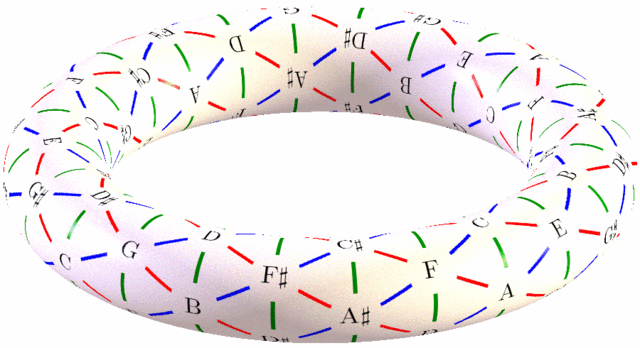
An interesting variation of the Tonnetz Grid shown above, is the Torus (or Donut-) shaped Neo-Riemannian Tonnetz Torus.
The red lines connect notes that are a Major Third (and Minor Sixth) apart. The green lines connect notes that are a Minor Third (and Major Sixth) apart. The blue lines connect notes that are a Perfect Fifth / Perfect Fourth apart.
With those 3 lines (one of each color) triangles can be formed. These triangles represent either Major (red–green–blue / RGB) or Minor (green–red–blue) Triad (3-tone) Chords.


